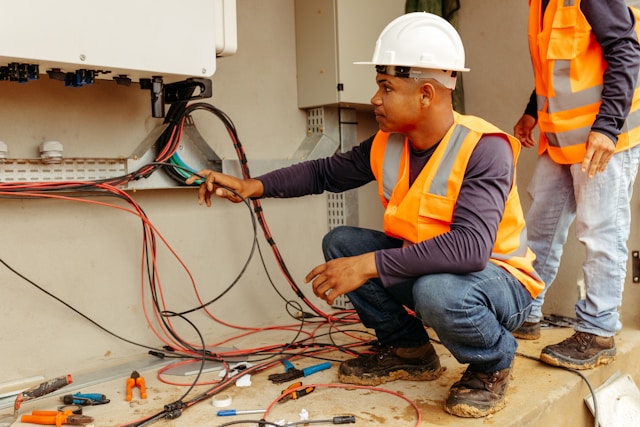
Acquiring an electrical contracting business is a significant investment that requires a comprehensive due diligence process. Whether expanding your existing operations or entering the electrical services market, conducting a detailed evaluation ensures that the acquisition aligns with your strategic goals and mitigates potential risks. This article outlines a practical due diligence framework that buyers can follow to assess electrical contractor acquisitions successfully.
Assessing the Target Company’s Financial Health
The financial stability of an electrical contractor is a key factor in determining whether the business is worth acquiring. Start by reviewing the company’s financial statements, including balance sheets, income statements, and cash flow statements from the past three to five years. This review will help identify revenue trends, profitability, and any financial red flags. Particular attention should be paid to accounts receivable, as delays in payments from clients can signal future cash flow problems.
Beyond basic financials, examining the contractor’s tax records and ensuring that all taxes have been properly filed and paid is essential. Unpaid taxes can be a significant liability for new owners, potentially derailing an otherwise sound acquisition. Evaluate whether the business has faced audits and review any resulting findings or penalties to avoid surprises post-acquisition.
Understanding the Client Base and Contracts
A contractor’s existing client base is a major asset in any acquisition, but it’s crucial to understand the nature of these relationships. Request a breakdown of the company’s client list, including long-term contracts and recurring work agreements. The value of the acquisition can increase significantly if the contractor has ongoing contracts with major clients or municipalities.
Additionally, assess the diversity of the client base. A contractor overly reliant on a few clients may be at risk if one or more of those relationships falter. Investigating how the contractor sources its business, the length of its contracts, and client retention rates can provide a clear picture of the business’s stability and growth potential.
Examining Licensing, Certifications, and Compliance
Electrical contracting is highly regulated, and compliance with local, state, and federal regulations is non-negotiable. Ensure that the contractor has all the necessary licenses and certifications to operate legally in its jurisdictions. Missing or expired permits can result in fines, legal challenges, or even the shutdown of operations.
In addition to licenses, verify that the contractor adheres to safety standards and protocols outlined by OSHA (Occupational Safety and Health Administration). A company with a history of safety violations may face penalties and risk damaging its reputation. Review any past safety incidents, including worker injuries or accidents, and check whether they led to litigation or insurance claims.
Evaluating the Workforce and Subcontractor Relationships
An electrical contractor’s workforce is vital, especially in an industry that relies heavily on skilled labor. Investigate the size, experience, and qualifications of the company’s employees, including electricians, project managers, and administrative staff. Understanding workforce turnover rates is also essential—high turnover could indicate internal problems, such as dissatisfaction with management or compensation.
Beyond the in-house workforce, many electrical contractors rely on subcontractors for larger projects. Assessing the contractor’s relationships with subcontractors and their reliability is important. Review any agreements with subcontractors and ensure they comply with the necessary regulations. Understanding how these relationships are managed is key to evaluating how smoothly projects are completed and how well the contractor can scale its operations.
Reviewing Equipment, Assets, and Liabilities
Electrical contractors often rely on specialized equipment, vehicles, and tools to conduct their work. Request a full inventory of the company’s equipment and assets as part of your due diligence. Evaluate the condition of these assets and assess whether they will require significant investment or replacements shortly. Any outdated or poorly maintained equipment could add unexpected costs after acquisition.
Similarly, review any existing liabilities, including outstanding loans or lines of credit, vehicle leases, and equipment financing. It’s crucial to understand the terms of these agreements to ensure that the contractor is not over-leveraged. Additionally, verify whether the company owns its real estate or leases its facilities, and evaluate any lease agreements to ensure they align with your long-term business plans.
Investigating Legal and Insurance Considerations
Legal due diligence is another crucial component of the acquisition process. Start by reviewing any past or ongoing litigation involving the contractor. Lawsuits related to contract disputes, safety violations, or employment matters can pose serious financial and reputational risks. Ensure that you have a clear understanding of the outcomes or potential liabilities associated with these legal issues.
Insurance coverage is also critical. Ensure that the contractor holds adequate insurance for its operations, including general liability, workers’ compensation, and property insurance. Investigate any insurance claims the company has made in the past, as repeated claims could indicate poor risk management. Adequate coverage is essential to protecting the business from unforeseen incidents post-acquisition.
Assessing Market Position and Growth Potential
A contractor’s position within its market can be a strong indicator of future growth. Analyze the company’s competitors and standing within the industry. Consider the contractor’s market share, reputation, and competitive advantages. You may also want to examine customer reviews, testimonials, and industry ratings to understand its reputation better.
Additionally, explore the potential for future growth. Are there opportunities to expand into new regions, take on larger projects, or diversify services? A contractor that demonstrates growth potential can provide significant value over time. Understanding the market and competitive landscape will help you assess whether the acquisition can help your business grow in alignment with long-term goals.